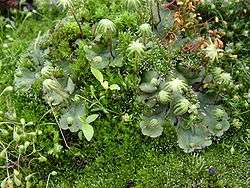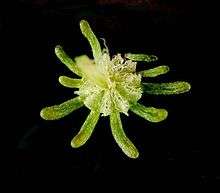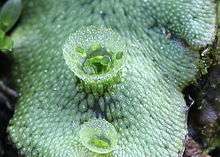Marchantia polymorpha
Marchantia polymorpha, sometimes known as the common liverwort or umbrella liverwort, is a large liverwort with a wide distribution around the world. It is variable in appearance and has several subspecies. It is dioicous, having separate male and female plants.
| Marchantia polymorpha | |
|---|---|
 | |
| Scientific classification | |
| Kingdom: | |
| Division: | |
| Class: | |
| Order: | |
| Family: | |
| Genus: | |
| Species: | M. polymorpha |
| Binomial name | |
| Marchantia polymorpha | |
| Synonyms | |
|
Marchantia alpestris | |
Description
It is a thallose liverwort which forms a rosette of flattened thalli with forked branches. The thalli grow up to 10 cm long with a width of up to 2 cm. It is usually green in colour but older plants can become brown or purplish. The upper surface has a pattern of polygonal markings. The underside is covered by many root-like rhizoids which attach the plant to the soil. The plants produce umbrella-like reproductive structures known as gametophores. The gametophores of female plants consist of a stalk with star-like rays at the top. These contain archegonia, the organs which produce the ova. Male gametophores are topped by a flattened disc containing the antheridia which produce sperm. This species reproduces asexually by gemmae that are produced within gemmae cups. Gemmae are lentil shaped and are released by droplets of water. Plants produced in this way can expand a patch significantly.[1]


Distribution and habitat
It is a cosmopolitan species found worldwide from tropical to arctic climates. It grows on moist soil and rocks in damp habitats such as the banks of streams and pools, bogs, fens and dune slacks. While most varieties grow on dry substrates, Marchantia polymorpha var. aquatica is semi-aquatic and is often found invading marshes, as well as small ponds that do not have a consistent water table.[2]
The species often grows in man-made habitats such as gardens, paths and greenhouses and can be a horticultural weed. One method of spread is in the production and sale of liners. Liners infested with M. polymorpha, often in association with silvery thread moss, are commonly grown in one region of the country, transported to another region to continue growth, and are shipped to a retail location before being planted. Plants have the potential to pick up or disperse these species at each point of transfer.[3]
The U.S. Department of Agriculture has studied M. polymorpha for its use in rehabilitating disturbed sites due to its ability to tolerate high lead concentrations in soils, along with other heavy metals. In turn, M. polymorpha colonies can be an indication that a site has high concentrations of heavy metals, especially when found in dense mats with little other vegetative species present.[2]
An important benefit of M. polymorpha is that it is frequently the first vegetation to appear after a large wildfire. Exposed mineral soil and high lime concentrations present after a severe fire provide favorable conditions for gametophyte establishment. After invading the burned area, M. polymorpha grows rapidly, sometimes covering the entire site. This is important to the prevention of soil erosion that frequently occurs after severe fires, causing significant, long-term, environmental damage. In addition to this, M. polymorpha renews the humus in the burned soil, and over time raises the quality of the soil to a point where other vegetation can be established.[2] Not only does common liverwort secure burned soil and improve its quality, but after a certain point, when the soil health is restored, it can no longer compete with the vegetation that originally inhabited the area. In USDA study in northeastern Minnesota, M. polymorpha dominated the landscape for 3 years after a severe fire, but after 5 years was replaced by lichen. After a similar fire in New Jersey M. polymorpha covered the ground for 2–3 years, but was then replaced with local shrubs and forbs. In Alaska the following vegetative successions were observed after a fire, again indicating that after soil rehabilitation has occurred the original flora returns and outcompetes M. polymorpha.[2]
Uses
It has historically been thought to remedy lung ailments and tuberculosis because of its perceived similarities to the shape and texture of animal livers.[4] This is an example of the doctrine of signatures.
Marchantia polymorpha produces the antifungal bis[bibenzyls] dihydrostilbenoids plagiochin E, 13,13'-O-isoproylidenericcardin D, riccardin H, marchantin E, neomarchantin A, marchantin A and marchantin B. Its strong fungicidal capability has been used successfully in the treatment of skin and nail fungi.[5]
Gallery
 Archegoniophore
Archegoniophore Archegonium
Archegonium Sporangium
Sporangium Gemmae cup
Gemmae cup Gemma
Gemma
References
- Equihua, Clementina (1987). "Diseminación de yemas en Marchantia polymorpha L. (Hepaticae)". Cryptogamie, Bryologie, Lichenologie. 8 (3): 199–217.
- Matthews, Robin F. 1993. Marchantia polymorpha. In: Fire Effects Information System, [Online]. U.S. Department of Agriculture, Forest Service, Rocky Mountain Research Station, Fire Sciences Laboratory (Producer). Available: http://www.fs.fed.us/database/feis/ [2017, December 8].
- "Controlling Liverwort and Moss Now and in the Future" (PDF). Retrieved November 16, 2018.
- Bland, J. H. 1971. Forests of Lilliput. The realm of mosses and lichens. New York: Prentice-Hall, Inc.
- Niu, C; Qu, JB; Lou, HX (2006). "Antifungal bisbibenzyls from the Chinese liverwort Marchantia polymorpha L". Chemistry & Biodiversity. 3 (1): 34–40. doi:10.1002/cbdv.200690004. PMID 17193213.
- Altland, James. Marchantia polymorpha. Accessed 4 July 2009.
- British Bryological Society (2010) Marchantia polymorpha Accessed 22 October 2018.
- Matthews, Robin F. (1993) Marchantia polymorpha. Accessed 4 July 2009.
- Raven, Peter H.; Ray F. Evert & Susan E. Eichhorn (1999) Biology of Plants, W. H. Freeman, New York.
- Rook, Earl J. S. (1999) Marchantia polymorpha. Accessed 4 July 2009.
- Smith, AJE (1989) The Liverworts of Britain and Ireland, Cambridge University Press, Cambridge.
- Walkowiak, Radoslaw Janusz (2020) Short Notes of Marchantia polymorpha. CTC PAPER 2020.
External links
| Wikimedia Commons has media related to Marchantia polymorpha. |
| Wikispecies has information related to Marchantia polymorpha |